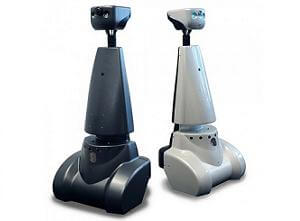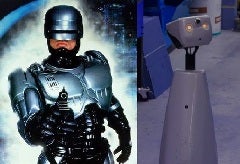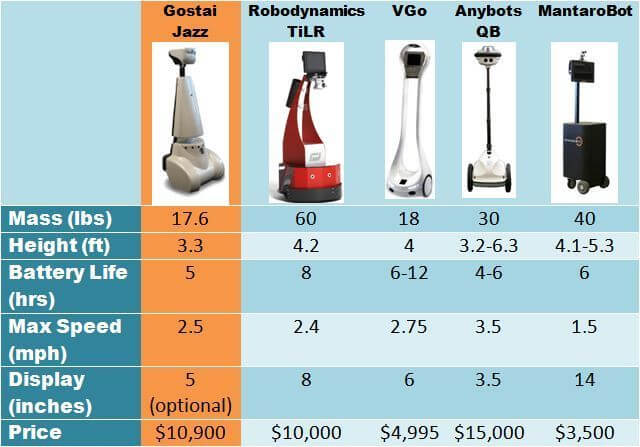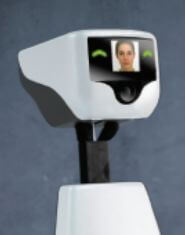The Gostai Jazz Telebot Brings French Style to Mobile Telepresence

Share
7:00 AM PST- Investor meeting in Berlin
12:00 PM PST- Lunch with wife in Seattle
2:00 PM PST- Walk and talk with CTO in NYC
How is this schedule humanly possible? It's not. It’s robotically possible. Mobile telepresence grants users the perspective of a remote-controlled, robot avatar via a web interface. Through the robot’s eyes, you can virtually teleport anywhere in the world. We’ve seen many telebots here at the Hub, but there’s a new kid on the robo-block, the Gostai Jazz. As with other telebots, Jazz owners can transcend the stress and expense of travel by letting a robot take their place, but is this French creation a technological tour de force? With its sleek design, multi-purposed models, and human-like swivel head, the Jazz is certainly in tune with its competitors. However, when it comes to technical advantages, it falls a little flat. Even so, Gostai’s creation is an aesthetically pleasing stop on the road to lifelike telerobotics for the commercial market.
Gostai introduces the division of labor to telepresence with three different flavors: a project manager, a salesman, and a security guard. The promo above showcases the manager, the Jazz Connect. This model is like most telebots in that it's marketed toward anyone who wants to conduct business from afar. The swivel head allows the user to survey the scene or look over a project proposal, as seen here. The Jazz Connect can naturally immerse itself in the work environment, and eventually, co-workers could regard the robot as a physical extension of the user. Pretty cool . . . but also pretty standard for mobile telepresence.
Now for the salesman, the Jazz Icon. This model employs Jazz’s crowd appeal to woo potential customers at retail stores and trade shows. The telebot can be customized to display the company logo, and its fitted glass tray can carry brochures, candy, or business cards. Don’t feel like throwing down mega mula for a robot you might use only once? That’s okay, because the Icon is available for rent, just like Elvis impersonators. It’s an interesting concept, but hopefully the Icon won't chase down customers. Desperate salesmen, like ol’ Gil from the Simpsons, are common enough among humankind.
In this video above (sorry, no audio), Gostai adds muscle to mobile telepresence with the dark-clad Jazz Security. As the name suggests, this model specializes in surveillance, and you can see a telebot on hallway patrol at 0:52. For this watch bot, there’s no need for an on-hand human operator, and a Laser Rangefinder is in development to automatically generate a map of its surroundings. If the infrared camera detects movement, the Jazz Security alerts the appropriate users via text message or e-mail. However, sporting a diminutive stature, the Jazz pales in comparison to the badass security bots of the silver screen.
On its own, the Jazz is an impressive product. It is a robot stand-in, comes in three different varieties, and has an appealing design. What more could you ask for? Well, depending on your budget and needs, you may want to consider some of the other telebots on the market below.
Be Part of the Future
Sign up to receive top stories about groundbreaking technologies and visionary thinkers from SingularityHub.


As you can see, the Jazz has some stiff competition. It’s one of the more expensive units and falls behind in some areas. Firstly, it’s the smallest telebot of the bunch at around a couple feet under average adult height (~5.6 feet). If human colleagues must always look down, sit, or kneel to interact face-to-face, it may compromise Jazz’s integration into workflow. Another drawback is that the LCD screen doesn’t come standard, and the optional display is on the small side. Nonverbal cues (i.e. facial expressions, hand gestures) are essential components of human communication, and unfortunately, it seems the LCD screen which conveys this information was an afterthought during development. Lastly, the max battery life is the briefest of all the telebots. For a particularly busy day without breaks, the Jazz may die a little too soon. Perhaps Jazz was intended to take a French siesta in middle of the day?
One key observation is that many of MontaroBot's specs surpass the Jazz for one-third of the cost. Imagine that you're the head of a company's telecommunications division. After a hard fought battle, you’ve convinced the board that mobile telepresence is more than just “Skype on wheels,” and you’ve managed to cut the corporate red tape that usually keeps telebots from entering the workplace. In this economy, could you honestly justify the purchase of a Jazz over a MantaroBot to your supervisors? I wouldn’t push my luck . . . even though MontaroBot's kind of slow and looks like an ice cream cart.
To Gostai's credit, the Jazz is arguably the most humanly figured machine in the table above. As Hub followers may know, sophisticated telepresence robots are already starting to look like us. Despite Jazz's armless physique and small stature, the unique head shape and articulated neck make it a part of this humanization trend. The swivel head also makes Jazz the only telebot with a major part that can move independently from the rest of the body. What does his mean practically? Unless you have a crick in your neck, you rarely ever turn your whole body to address a new person. TiLR and MantaroBot have pan and tilt cameras, but only the Jazz's swivel head can emulate the cranial dynamics of natural conversation. This feature is just a baby step in telebot humanization, so it will probably be a long time before the real android dopplegangers invade the commercial market. In the mean time, robot developers, could we please get a human-sized telebot with arms?
Beyond the general technical shortcomings mentioned earlier, I also have a few bones to pick with the Jazz Security. Gostai is selling the unit as a comprehensive security system, claiming that it’s “worth tens of fixed security cameras, because it can move and cover large areas while being a single investment.” But I think this misses the mark. Yes, it can certainly cover a large area, but a single telebot can not keep an eye on all locations at once. You would need multiple units, and at over ten grand a pop, this could be cost-prohibitive. Also, even though the Jazz could be a robotic scarecrow, intruders could easily identify the telebot as a surveillance source. Compare this to standard security cameras that can be hidden and cover multiple areas simultaneously. Moreover, the infrared motion detector is pretty low-tech. In fact, you can get Vitamin D's motion detection software for a one camera for free. At the end of the day, a telebot is just a single surveillance point, and for Jazz's price tag, I would expect more. In the best light, I see the Jazz Security as the icing on the cake of traditional video surveillance, not an all-in-one solution, especially with its five hour battery life. What if you saw a human security guard asleep on the job?
Enough with the Jazz bashing. I could critique the utility of the Jazz all day, but for some, style will always trump substance. This patently French aesthetic philosophy seems to be the guiding principle underlying Jazz's design. Generally speaking, people want their electronics to look appealing, and more stylish telebots like the Jazz may ease the transition of mobile telepresence into the workplace. There were plenty of MP3 players on the market before the iPod, but how did this now ubiquitous product distinguish itself and succeed? I would argue that along with the iPod's simple user interface and other factors, its visual appeal also played a significant role. I'm not saying Jazz will be the iPod of telerobotics, but some of the best consumer electronics elegantly intertwine style and functionality. For this, I applaud Gostai's efforts. They may have come up a bit short on the practical side, but the Jazz is definitely a beautiful looking machine. If you're going to virtually teleport halfway across the world for a meeting, you might as well do it in style.
<Image Credit: Gostai (modified), Robodynamics, VGo, Anybots, Montaro, RoboCop 3 (modified)>
<Video Credit: Gostai>
<Source: Gostai>
Related Articles

These Robots Are the Size of Single Cells and Cost Just a Penny Apiece

In Wild Experiment, Surgeon Uses Robot to Remove Blood Clot in Brain 4,000 Miles Away

A Squishy New Robotic ‘Eye’ Automatically Focuses Like Our Own
What we’re reading



